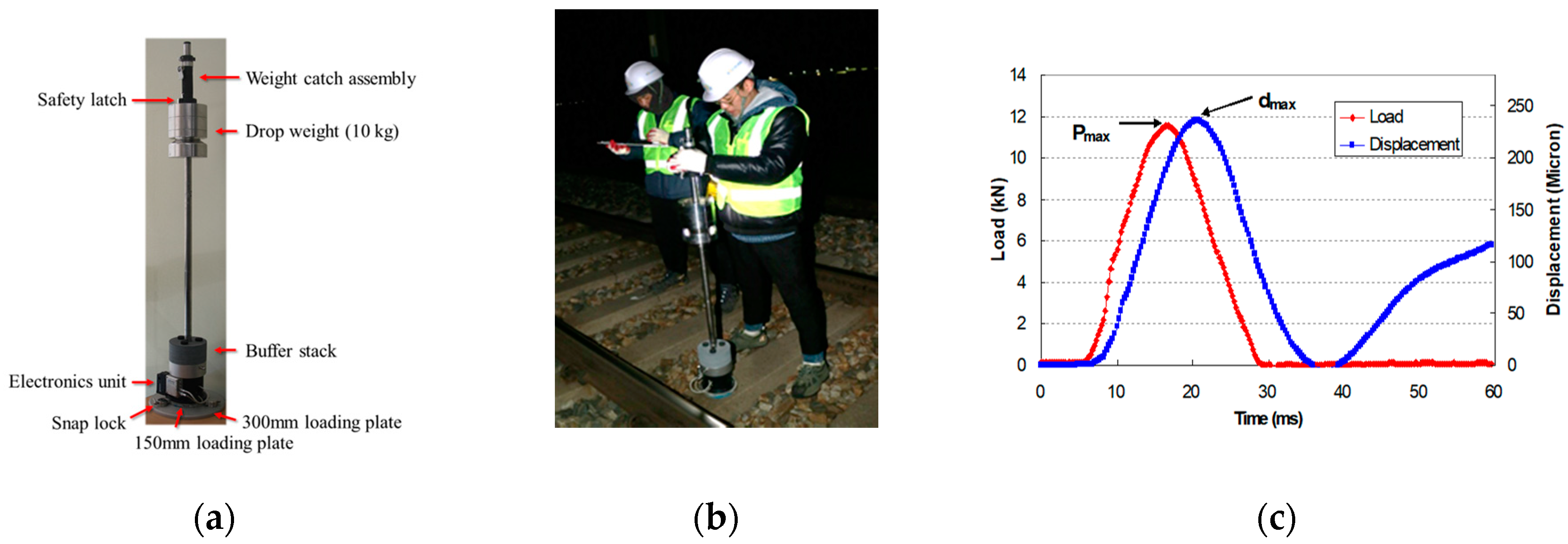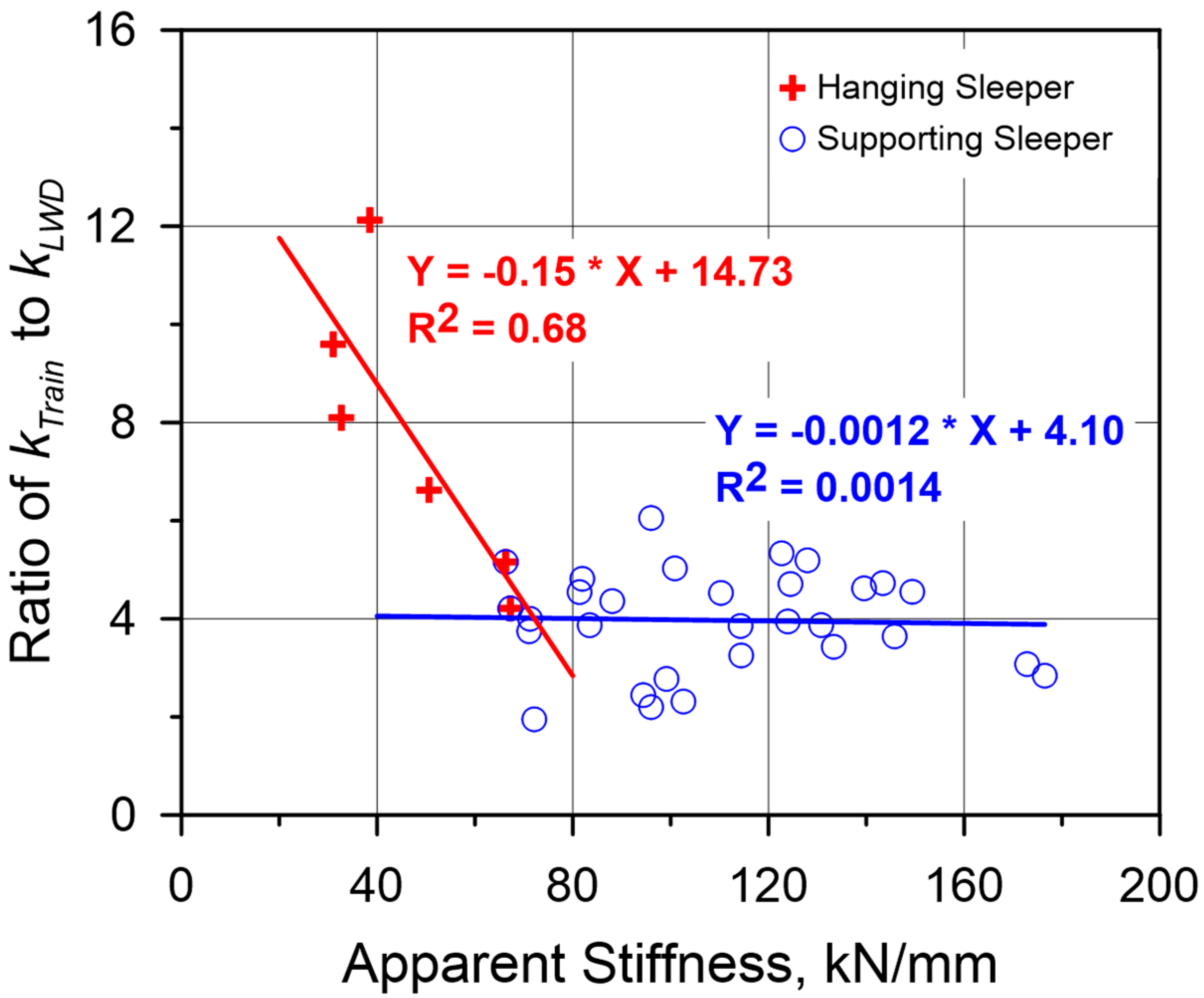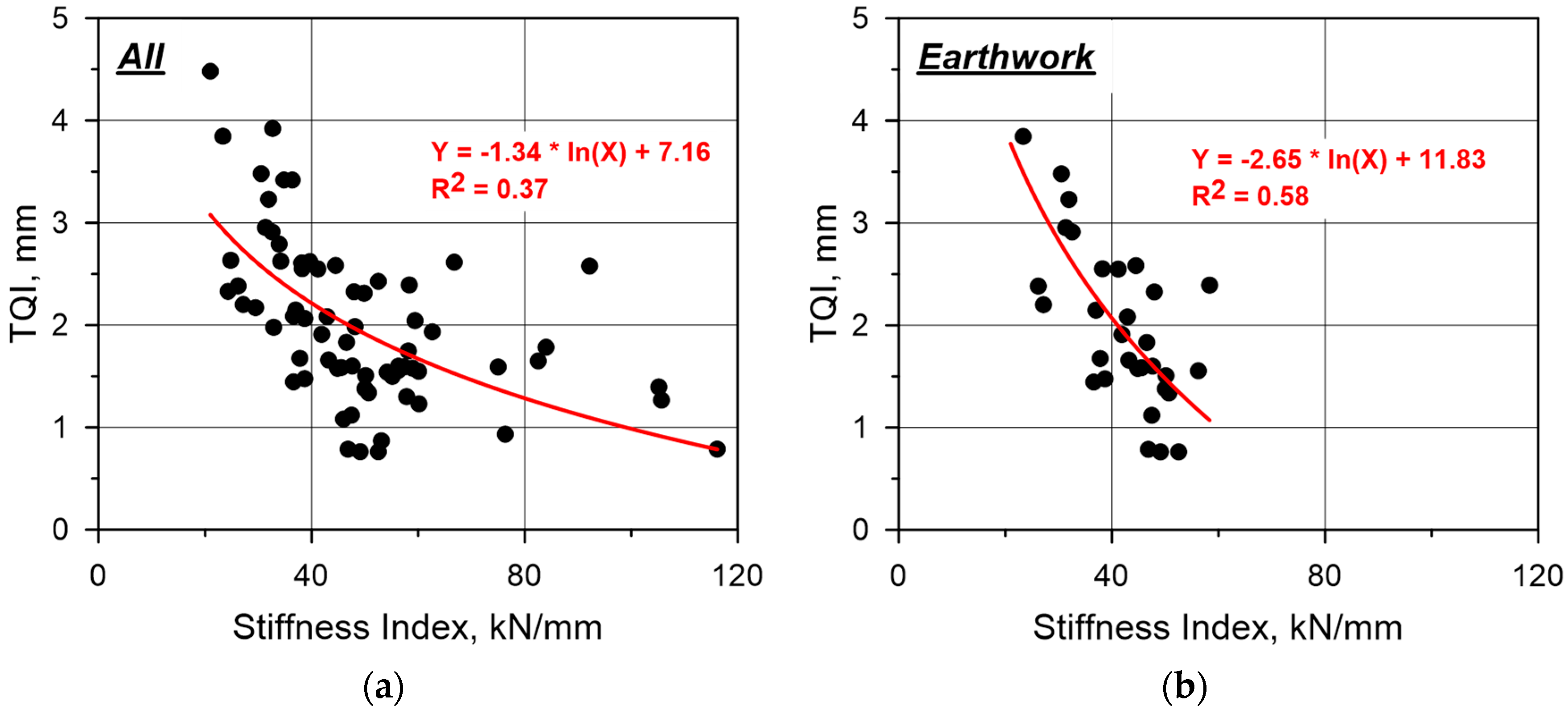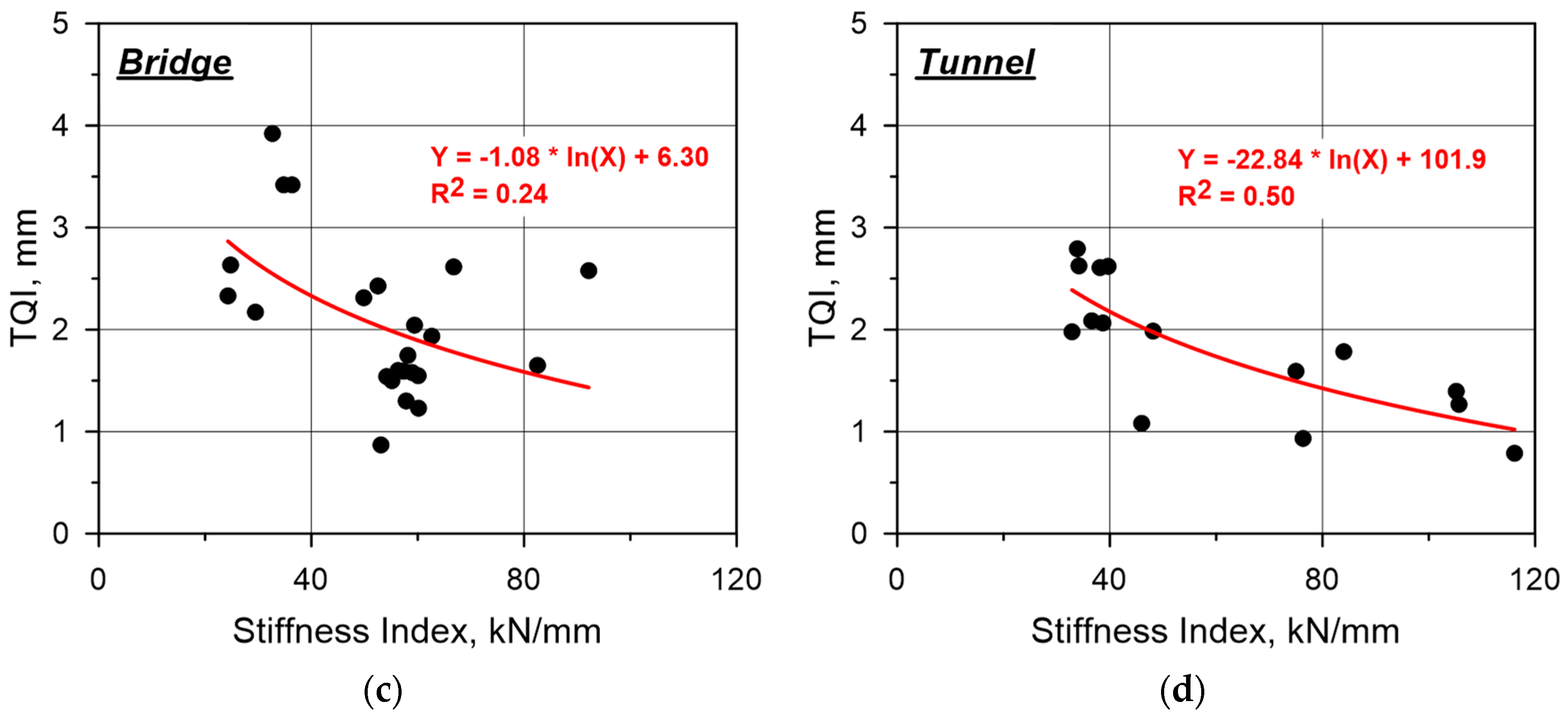Ballasted Track Status Evaluation Based on Apparent Track Stiffness Index
Abstract
1. Introduction
2. Main Concepts
2.1. Apparent Track Stiffness
2.1.1. Light Falling Weight Deflectometer (LFWD)
2.1.2. Classification of Supporting and Hanging Sleepers Using LFWD
2.2. Field Test
2.2.1. Field Test Overview
2.2.2. Apparent Stiffness Distribution Characteristics
3. Ballasted Track Status Test Indicator
3.1. Apparent Track Stiffness vs. TQI
3.2. Apparent Track Stiffness vs. Cumulative Tamping Length
3.3. Track Stiffness Index
4. Track Status Evaluation Based on the Track Stiffness Index
4.1. Track Status Evaluation Standard
4.2. Track Status Evaluation Standard Verification
5. Conclusions
- The investigation of the apparent stiffness distribution for each substructure confirmed that not only the rail, sleeper, and track stiffness but also substructure characteristics were reflected in the apparent stiffness. Therefore, it is necessary to classify sections by substructure to evaluate the track status based on apparent stiffness.
- The correlation among the average apparent track stiffness, TQI, and cumulative tamping length was found to be very poor, whereas the correlation with the track stiffness index combining average and standard deviation was very high. Therefore, the average apparent track stiffness and standard deviation must be considered simultaneously to properly evaluate the status of the track.
- Based on the track stiffness index, TQI, and cumulative tamping length correlation, the standards for evaluating the track status in terms of five levels using the track stiffness index were presented. The standards vary with the substructure type. For bridges, the stiffness index values for each level are 184, 128, 81, and 51 kN/mm. For tunnels, the stiffness index values for each level are 137, 87, 50, and 28 kN/mm. For earthwork, the stiffness index values for each level are 90, 67, 47, and 33 kN/mm.
- Based on the verification of the evaluation standard presented on the basis of additional field surveys, it was found that the status of the track based on the track stiffness index and that based on the TQI showed consistency for the earthwork sections. For the bridges, the correlation between the track stiffness index and TQI was relatively low, and the evaluated track status was also inconsistent.
- On the other hand, the status of the track based on the track stiffness index and that based on the cumulative tamping length showed consistency for one of the earthwork sections and a bridge section. This means that the stiffness index can reflect not only TQI but also the cumulative tamping length. Besides this, it is thought that inconsistency can be overcome when the correlation increases by accumulating more data through additional field surveys.
Author Contributions
Funding
Conflicts of Interest
References
- Korea Rail Network Authority. Railway Track Maintenance Guidelines; Korea Rail Network Authority: Daejeon, Korea, 2015. [Google Scholar]
- Leng, Z.; Al-Qadi, I.L. Railroad ballast evaluation using ground-penetrating radar: Laboratory investigation and field validation. Transp. Res. Rec. 2010, 2159, 110–117. [Google Scholar] [CrossRef]
- Zhang, Y.; Venkatachalam, A.S.; Xie, Y.; Wang, G.; Xia, T. Data analysis technique to leverage ground penetrating radar ballast inspection performance. In Proceedings of the IEEE Radar Conference, Cincinnati, OH, USA, 19–23 May 2014; pp. 463–468. [Google Scholar]
- Indraratna, B.; Khabbaz, H.; Salim, W.; Christie, D. Geotechnical properties of ballast and the role of geosynthetics in rail track stabilization. Proc. Inst. Civ. Eng. Ground Improv. 2006, 10, 91–102. [Google Scholar] [CrossRef]
- Smekal, A.; Berggren, E.G.; Silvast, M. Monitoring and substructure condition assessment of existing railway lines for upgrading to higher axle loads and speeds. In Proceedings of the 7th World Congress on Railway Research, Montreal, QC, Canada, 4–8 June 2006. [Google Scholar]
- Hunt, G.A. EUROBALT optimises ballasted track. Railw. Gaz. Int. 2000, 156, 813–816. [Google Scholar]
- Lichtberger, B. Track Compendium: Formation, Permanent Way, Maintenance, Economics; Eurail Press: Hamburg, Germany, 2005; pp. 48–54. [Google Scholar]
- Milosavljevic, L.; Popovic, Z.; Lazarevic, L. Track stiffness and the vertical track geometry deterioration modeling. Mech. Eng. 2012, 10, 157–162. [Google Scholar]
- Puzavac, L.; Popovic, Z.; Lazarevic, L. Influence of track stiffness on track behaviour under vertical load. Promet-Traffic Transp. 2012, 24, 405–412. [Google Scholar] [CrossRef]
- Berggren, E.G. Railway Track Stiffness: Dynamic Measurement and Evaluation for Efficient Maintenance. Ph.D. Thesis, KTH Royal Institute of Technology, Stockholm, Sweden, 2009. [Google Scholar]
- Furukawa, A. Recent tendencies in ballasted track maintenance. Q. Rep. Railw. Tech. Res. Inst. 2016, 57, 80–84. [Google Scholar] [CrossRef]
- Kim, D.S.; Kwon, S.S.; Lee, S.H.; Hwang, S.K.; Park, T.S. Study on the appropriateness of track maintenance works through the evaluation of trackbed conditions. J. Korean Soc. Railw. 2008, 11, 334–341. [Google Scholar]
- Choi, Y.T.; Hwang, S.H.; Jang, S.Y.; Park, B.; Shim, G.S. Evaluation of applicability of apparent track stiffness measured by light-weight deflectometer as a ballasted track condition index. J. Korean Geo-Environ. Soc. 2018, 19, 37–44. [Google Scholar]
- Park, B.; Choi, Y.T.; Hwang, S.H. Evaluation of apparent track stiffness according to loading level: Light-weight deflectometer and train loading. J. Korean Soc. Railw. 2018, 21, 690–700. [Google Scholar] [CrossRef]
- Sussmann, T.R.; Ebersohn, W.; Selig, E.T. Fundamental non-linear track load-deflection behavior for condition evaluation. Transp. Res. Rec. 2001, 1742, 61–67. [Google Scholar] [CrossRef]











| Year of Measurement | Section Name | Structure Category | Location |
|---|---|---|---|
| 2017 | Sandong Bridge 3 | BR 1 -EW 2 | T1 092k050-092k340 |
| Yongwa tunnel–Sandong Bridge 1 | TN 3 -EW-BR | T1 089k200-089k580 | |
| Seolgyae Bridge | BR-EW | T1 195k240-195k510 T2 195k240-195k530 | |
| Palgok overpass–Banwol tunnel | BR-EW-TN | T1 035k850-036k415 | |
| Pyeongtaek overpass | BR-EW | T1 075k050-075k272 | |
| Paengseong overpass 2–Wunyong overpass 1 | BR-EW-BR | T1 077k740-078k530 | |
| Shinjeong Bridge–Wunju tunnel | BR-EW-TN | T1 111k750–112k050 | |
| Galhang overpass–Geumoh tunnel | BR-EW-TN | T2 241k160-241k460 | |
| Daejeonbuk connection line | BR-EW | T2 153k814-154k012 | |
| Seobong tunnel 2 | TN | T1 053k250-054k350 | |
| 2018 | Galhang overpass–Geumoh tunnel | BR-EW-TN | T2 241k160-241k460 |
| Shinhue overpass | BR | T2 085k400-085k640 | |
| Godeung tunnel | EW-TN | T1 107k300-107k600 | |
| Pungsae Bridge | EW | T2 099k600-099k635 | |
| Paengseong overpass 1 | EW-BR | T2 075k490-075k690 | |
| Geumgang Bridge | EW-BR | T1 182k950-183k480 | |
| Yongwa tunnel | TN-EW | T1 089k200-089k350 T2 089k200-089k236 | |
| 2019 | Geumgang Bridge | EW-BR | T1 182k950-183k480 |
| Pungsae Bridge–Godeung tunnel | BR-EW-TN | T1 107k032-107k479 | |
| Wunyong overpass 2 | EW | T2 081k850-081k729 | |
| Shinhue overpass | EW | T2 086k440-086k731 | |
| Pungsae Bridge | EW-BR | T2 100k240-100k389 |
| Structure | Apparent Stiffness (kN/mm) | Number of Measurement Sleepers | |
|---|---|---|---|
| Average | Standard Deviation | ||
| Earthwork | 98 | 54 | 4404 |
| Bridge | 118 | 50 | 2404 |
| Tunnel | 156 | 67 | 1186 |
| All | 112 | 58 | 7994 |
| Structure | Apparent Stiffness (kN/mm) | Number of Measurement Sleepers | |
|---|---|---|---|
| Average | Standard Deviation | ||
| Earthwork | 133 | 40 | 2632 |
| Bridge | 136 | 39 | 1887 |
| Tunnel | 177 | 51 | 935 |
| All | 142 | 45 | 5454 |
| Structure | Number | Ratio of Hanging Sleepers to Supporting Sleepers | |
|---|---|---|---|
| Supporting Sleepers | Hanging Sleepers | ||
| Earthwork | 2632 | 1772 | 0.67 |
| Bridge | 1887 | 517 | 0.27 |
| Tunnel | 935 | 251 | 0.27 |
| All | 5454 | 2540 | 0.47 |
| Category | α | ||||||
|---|---|---|---|---|---|---|---|
| 0.5 | 0.6 | 0.7 | 0.8 | 0.9 | 1.0 | ||
| TQI | All | 0.39 | 0.37 | 0.32 | 0.29 | 0.25 | 0.23 |
| Earthwork | 0.58 | 0.58 | 0.50 | 0.42 | 0.35 | 0.30 | |
| Bridge | 0.24 | 0.24 | 0.19 | 0.15 | 0.12 | 0.10 | |
| Tunnel | 0.62 | 0.61 | 0.60 | 0.59 | 0.58 | 0.58 | |
| Tamping length | All | 0.25 | 0.29 | 0.30 | 0.30 | 0.30 | 0.29 |
| Earthwork | 0.33 | 0.48 | 0.51 | 0.50 | 0.47 | 0.45 | |
| Bridge | 0.57 | 0.50 | 0.43 | 0.37 | 0.32 | 0.29 | |
| Tunnel | 0.41 | 0.45 | 0.49 | 0.51 | 0.52 | 0.54 | |
| Management Stage | Limits | |
|---|---|---|
| Construction value (CV) | Value required when a new track is constructed | N_SD_10m 1 ≤ 1.0 N_SD_20m 2 ≤ 1.3 |
| Target Value (TV) | Value required after maintenance work on a track (L < 100 m) | N_SD_10m ≤ 1.3 N_SD_20m ≤ 1.7 |
| Warning Value (WV) | Meaning of this stage: - To examine the cause of the defect and the associated characteristics - To monitor the progress status of lateral track irregularity | N_SD_10m ≥ 1.9 N_SD_10m ≥ 2.6 |
| Railway Track Maintenance Guidelines Management Stage | TQI | Stiffness Index (kN/mm) | Cumulative Tamping Length (m/m/year) | Status | ||||
|---|---|---|---|---|---|---|---|---|
| Bridge | Tunnel | Earthwork | Bridge | Tunnel | Earthwork | |||
| Construction value | 1.3 | 184 | 137 | 90 | - | - | - | Very Good |
| Target value | 1.7 | 128 | 87 | 67 | - | 3.0 | - | Good |
| (Target+Warning)/2 | 2.2 | 81 | 50 | 47 | 1.5 | 15.4 | 2.2 | Normal |
| - | 2.6 | 51 | 28 | 33 | 12.1 | 28.4 | 14.8 | Bad |
| Warning value | ≥ 2.6 | ≤ 51 | ≤ 28 | ≤ 33 | ≥ 12.1 | ≤ 28.4 | ≥ 14.8 | Very Bad |
| Station (m) | Structure | Apparent Stiffness (kN/mm) | Stiffness Index (kN/mm) | TQI | Cumulative Tamping Length | Track Status | |||
|---|---|---|---|---|---|---|---|---|---|
| Average | Standard Deviation | Stiffness Index | TQI | Tamping | |||||
| 081k580~729 | Earthwork | 93 | 56 | 37 | 2.4 | 2.0 | Bad | Bad | Normal |
| 086k440~731 | Earthwork | 100 | 39 | 60 | 2.2 | 2.1 | Normal | Normal | Normal |
| 100k240~389 | Bridge | 114 | 53 | 60 | 1.7 | 2.6 | Bad | Good | Bad |
© 2020 by the authors. Licensee MDPI, Basel, Switzerland. This article is an open access article distributed under the terms and conditions of the Creative Commons Attribution (CC BY) license (http://creativecommons.org/licenses/by/4.0/).
Share and Cite
Park, B.; Choi, Y.-T.; Hwang, S.H. Ballasted Track Status Evaluation Based on Apparent Track Stiffness Index. Appl. Sci. 2020, 10, 4729. https://doi.org/10.3390/app10144729
Park B, Choi Y-T, Hwang SH. Ballasted Track Status Evaluation Based on Apparent Track Stiffness Index. Applied Sciences. 2020; 10(14):4729. https://doi.org/10.3390/app10144729
Chicago/Turabian StylePark, Bongsik, Yeong-Tae Choi, and Sung Ho Hwang. 2020. "Ballasted Track Status Evaluation Based on Apparent Track Stiffness Index" Applied Sciences 10, no. 14: 4729. https://doi.org/10.3390/app10144729
APA StylePark, B., Choi, Y.-T., & Hwang, S. H. (2020). Ballasted Track Status Evaluation Based on Apparent Track Stiffness Index. Applied Sciences, 10(14), 4729. https://doi.org/10.3390/app10144729




